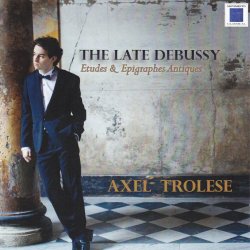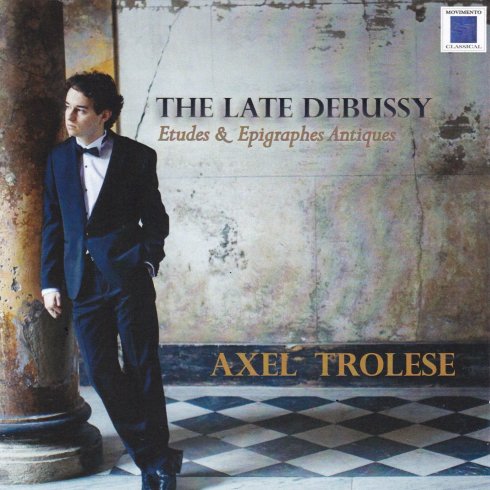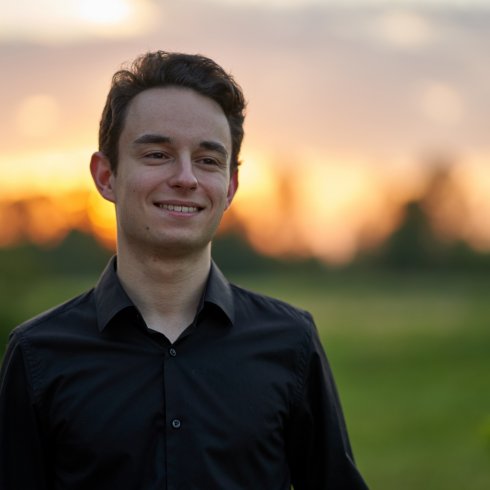

The late Debussy
The 12 Etudes
The great avant-garde music of the 12 ETUDES of Debussy takes its inspiration directly from another fundamemal expcrience or the history or pianistic composition: the two cycles or s tudie s op. IO and op. 25 or Frédéric Chopin. But although it may be that the begiuning of the Great War the sound or the piano “became hateful " to him. upon request of Durand, his editor. Debussy set about to revise the works or the Polish composer, therein finding a creative stimulus strong enough that it brought him to conceive and complete the two books of the Etudes in a single summer, that or 1915. in a moment of feverish compositional activity which saw him complete the Sonata for Celio and Piano, as well as that for Flute. Viola and Harp . Following the model of Chopin, the Etudes are divided into two books or six tracks each, in which, accompanying the traditional identification or passages or panicular technical-executional difficulty (such as the use or ali five fingers and passages in double thirds. sixths. and octaves) can be found, in the second volume above all, some speculations dedicated to gestures and pianistic timbres which were innovative but typical or his style, such as double founrth’s, "composed arpeggios” and “opposed souorities". Nonetheless, the Studies of Debussy are not strictly focused on the resolution or particular pianistic problerns, seeing as the intervals which he uses, the five or eight fingers and the composed arpeggios, are above all sound objects through which h explores compositional possibilities. A clear example or this approach is manifest in the opening track or the collection , the Étude pour les cinq doigts d' après Monsieur Czerny, in which the most classic exercise for the independence of the fingers is stripped of its didactic heritage and acquires a more noble dimension; herein tbe approach or Debussy is similar to that adopted in Doctor Gradus ad Parnassum. where Clementi was object or the same in which the by-now-adult pianist and composer recollected the period in which he too , had carried out the most elementary exercises or piano technique. The effervescence and the vivacity of this beginning soon makes way for the sinuous and homorythmic flow of the melodies of the Étude pour les tierces, which are develoep first in the middlelow part of the keyboard bcfore gradually becoming higher and higher; the flow is constant, impenurbable and hypnotic. and only on the final page does a dancing melody bubble up from the depths or the sound agglomerate, culminating in a vigorous finale full or sound.
Highly varied is the formal structure of the Etude pour les quartes in which the allure of the Oricntal sounding melodies is accompanicd by that sense of Oriental detached perfection which is inherent in the interval of a perfect fourth, uscd by Debussy much more than its diminished and augmented variants; in this case as well the overall direction carries towards a peak in tension, but the end is no longer explosive as in the previous track: the sound dilutes and its inertia progressively decays untiI it gradually extinguishcs in absolute silence. From this silence the Etude pour les sixtet takes file , bringing back the homorythmic component already present in the sccond track and imbuing it with a certain solemnity espccially in the initial and fìnal sections. Joy and dance. on the other hand, are al the base of that great virtuosistic challenge which is the Etude pour les octaves, making evident the choice of on itinerary which would lead towards the progressive broadening of the interval, reaching its maximum breadth in corrcspondence wiht the dynamic apex of the first book of the cycle. At the conclusion of the fìrst haif of the collection there is not, in any case, the liberating tearing away in quatrains of the demisemiquavers of the Etude pour les octaves (similar to thc finale of Golliwogs Cake-Walk). bui rather the elusive Etude pour les huit doigts : this is a modus operandi typical of Debussy (which, however, he will forego for the end of the second book), who tends to play with detachment from the sound object through an intellectualism in the treatment of musical malerials which anacsthetizes the previously crcated emotion. The motor of this track is constituted of the perpetum mobile of the quatrains of demisemiquavcrs, which deseribe most rapid ascending and descending motifs, broad scales brief trills, tremolos and glissandos which only just before the end leave way to an ambiguous melody, englobed in lhe general movment which has not yet been exhausted and which, quite to the contrary, progressively accelerates up to the point of litcrally doubling its , velocity in the penultimate measure.The Étude pour les es degrés chromatiqes, set at the beginning of the sccond book, seems to take direction from the end of the prvious study, surely for the playful tone with which it begins, not to mention the repetition of the quatrains - the unit of measure which the two tracks have in common; in this study Debussy frequcntly indicatces cresccndos, often very sudden, which never break into a liberating forte, but in wind up rather in piano, disappointing the expectations of the listener, projectcd at this point in a new depanure, which will culminate once again in a new beginning . The atmosphere which Debussy suggests for the Étude pour les agréments, and not so much its form, is that of an italian barcarolle. which rocks the listener in its undulating and placid momentum . Mysterious and questioning is the beginning of the Étude pour les notes répétées. In which the pianistic gesture, yet once more in quatrains, bounces along the whole length of the keyboard, describing perhaps the conduct of a minute but most clever, Debussian “Scarbo”, not as vicious as Ravel's original. The apex of the compositional rescarch of the entire collection is surely the Étude pour les senorites opposees in which the esoteric Debussy interrogates himself on the concept of opposition; this is present initially between the reisters of tlte key board and successively in dissonances( the fìrst two notes are separated only by a half), enhamonies (G # and A b), diffrent dynamics and timbres regulated by the key attack, which assumes, within this picee, a greater imponancc than usual. The Étude pour les arpèges composés originates from a small polar pentatonic melodie celi on A ftat, and herein the arpeggio as sound object instils the study with an elegant and sinuous momentum which in the second pan moves aside to make space for play and dance before making its retum in the initial spirit of the piece, though this time the arpeggio will culminate in silence. The Étude pour les accords the finale of the collection. dramatically breaks this silcnce and imposes itself upon the listener, dragging him or her into its dance, dictated by a rhythmic impulse marked by frequent accents and Syncopes which make it even more incisive; the second part of the track permits us to judge a posteriori all of the musical experiences had during the course of the other studies, as it represents a true moment of crisis in which we perhaps fell the unease of a civilization shaken by war emerge, while also evidencing a component linked to death which was present in all of the other studies, concealed and hidden as it may be,.In the second part of the final track we enter in a moment which is not subject to the passing of time, in which each and every musical occurrcnce is detached from the previous and the
successive one. making the identification of a logical thread impossible; nevertheless, this sense of disorientation is due a precise will which stands in opposition to disorganization, as rigid order is required in order to obtain disorder. This is probably the musical equivalent of the "stream of consciousness'' of James Joyce, in which we find ourselves with the thoughts of a character; and they are disconnected and often not organized grammaticaliy and logically. In our case, we enter in the creative mind of Debussy, in the very act of composition, in which some of the possible formal and musical solutions are at first attempted and then discarded before passing on to other ideas which at a cenain point, apparently by chance (but in reality under the attentive supervision of our author), bring us back to the movement of the initial dance, which sonorously and affirmatively concludes the 12Etudes.


Axel Trolese is an Italian pianist born in 1997. During his training he studied with some of the most important musicians internationally, including Louis Lortie, Benedetto Lupo, Maurizio Baglini and Denis Pascal. He obtained two degrees at the National Superior Conservatory of Paris and at the National Academy of Santa Cecilia, and the Diploma at the Monteverdi Conservatory of Cremona. He is an artist in residence at the Queen Elisabeth Music Chapel in Waterloo; moreover, his artistic activity is supported by the Associazione Culturale Musica con le Ali. A passionate interpreter of French music, in 2016 he dedicated his first album "The Late Debussy: Etudes &Epigraphes Antiques", positively reviewed on Repubblica, Musica, Amadeus, il Giornale della Musica and il Corriere dello Spettacolo. Awarded in numerous international competitions ("Ettore Pozzoli Piano Competition", "Grand Prix Alain Marinaro" and "Premio Venezia"), Axel Trolese has performed in many concert halls, including the Auditorium Parco della Musica in Rome, the Teatro La Fenice in Venice, the Salle Cortot in Paris, the Ministry of Culture French, the Millennium Concert Hall in Beijing , the Quirinal, Beaulieu Abbey in Hampshire, Amiata Piano Festival, the Roman Philharmonic Academy, the Museum of Fine Arts in Rouen, the Weimarhalle in Weimar and the Fazioli Concert Hall in Sacile.Some of his concerts have been broadcast live by Radio3, France Inter, Venice NClassic Radio and Radio MCA. He has also played with orchestras such as the Jenaer Philharmonike and the Roma Tre Orchestra, working with conductors such as Massimiliano Caldi, Markus L. Frank, Ovidiu Balan and Jesús Medina. Trolese appeared in a documentary made by ARTE dedicated to the Italian composer Roffredo Caetani, interpreting some of his compositions on the Bechstein grand piano given to him by his godfather Franz Liszt. He is the main protagonist and pianist of the short film "Danza Macabra" by the famous Italian director Antonio Bido, inspired by the homonymous symphonic poem by Saint-Saëns.
